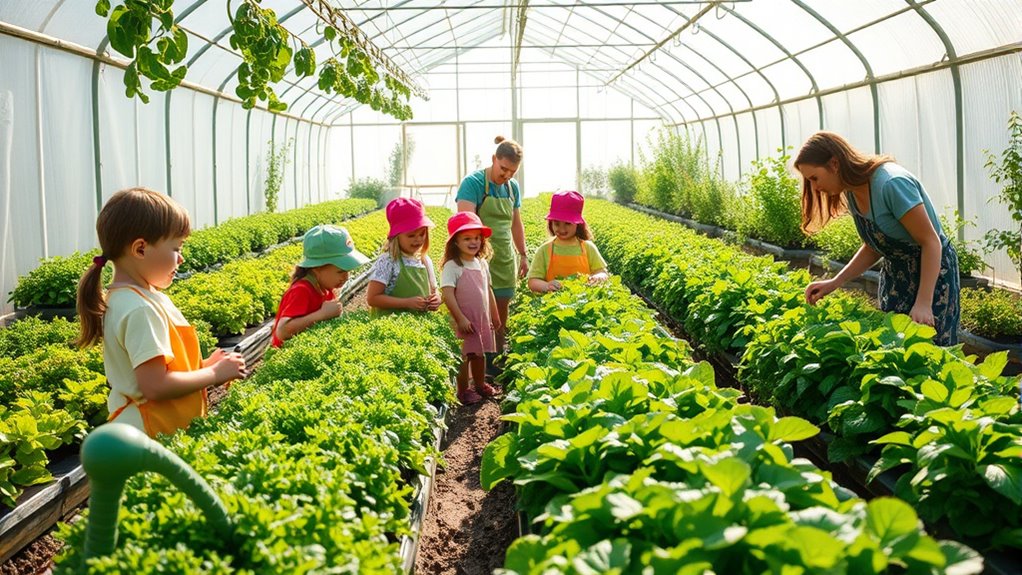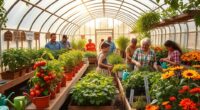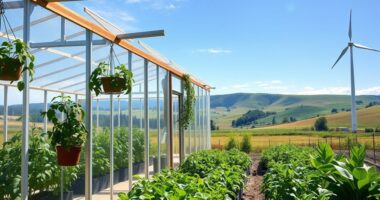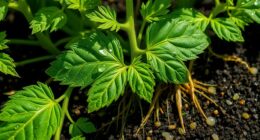Using greenhouses to teach children about sustainability offers hands-on experiences that boost eco-awareness and responsible habits. You can involve them in planting, caring for crops, and practicing water conservation, composting, and recycling. Incorporating technology teaches data collection and problem-solving skills. This approach helps children understand ecosystem interactions and develop stewardship for the environment. If you continue exploring, you’ll find ways to create engaging, eco-friendly spaces that inspire future environmental leaders.
Key Takeaways
- Greenhouses provide hands-on lessons about sustainable practices like solar energy, composting, and water conservation.
- Children learn ecosystem interactions, such as pollinators and soil microbes, fostering ecological awareness and responsibility.
- Practical activities like planting, caring for crops, and monitoring environmental data promote critical thinking and environmental stewardship.
- Incorporating eco-friendly materials and energy-efficient features teach children the importance of sustainable building and resource use.
- Greenhouse education encourages eco-friendly habits like recycling, reducing waste, and conserving water, shaping responsible environmental behaviors.
The Benefits of Using Greenhouses in Education
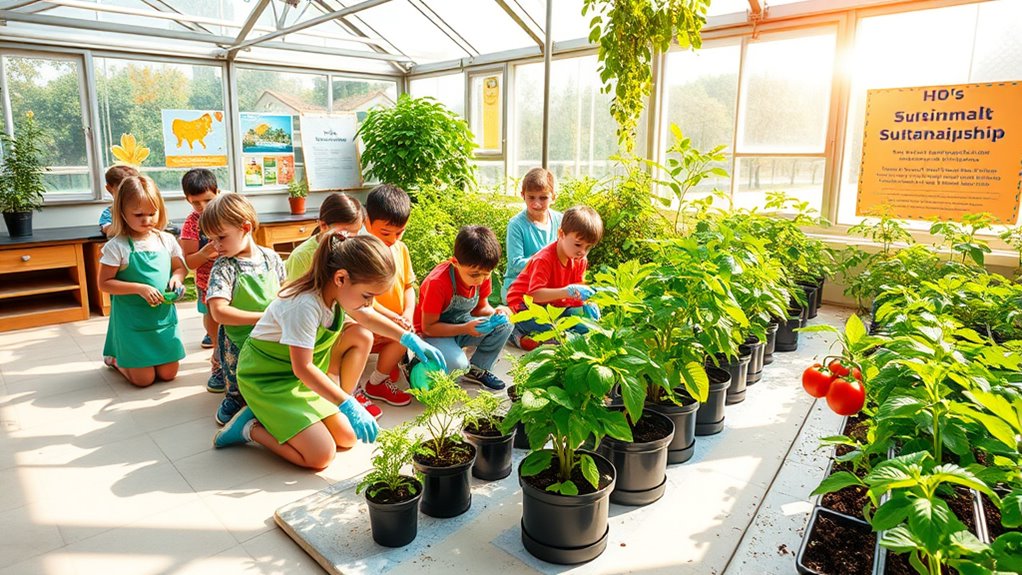
Have you ever wondered how greenhouses can enhance environmental education? Greenhouse architecture plays a crucial role by creating a controlled environment that mimics natural conditions. This setup allows students to observe plant growth and ecological processes firsthand, making learning more engaging. Additionally, greenhouses can be designed to incorporate sustainable building practices, further emphasizing the importance of eco-friendly construction. Climate control is a key benefit, as it lets you regulate temperature, humidity, and light, ensuring ideal conditions year-round. This consistency helps children understand how different factors impact plant development and sustainability. Greenhouses also serve as versatile learning spaces, encouraging hands-on activities like planting, watering, and caring for plants. By experiencing these elements directly, students develop a deeper appreciation for environmental stewardship and the importance of sustainable practices in a safe, controlled setting.
Designing a Child-Friendly Greenhouse Environment
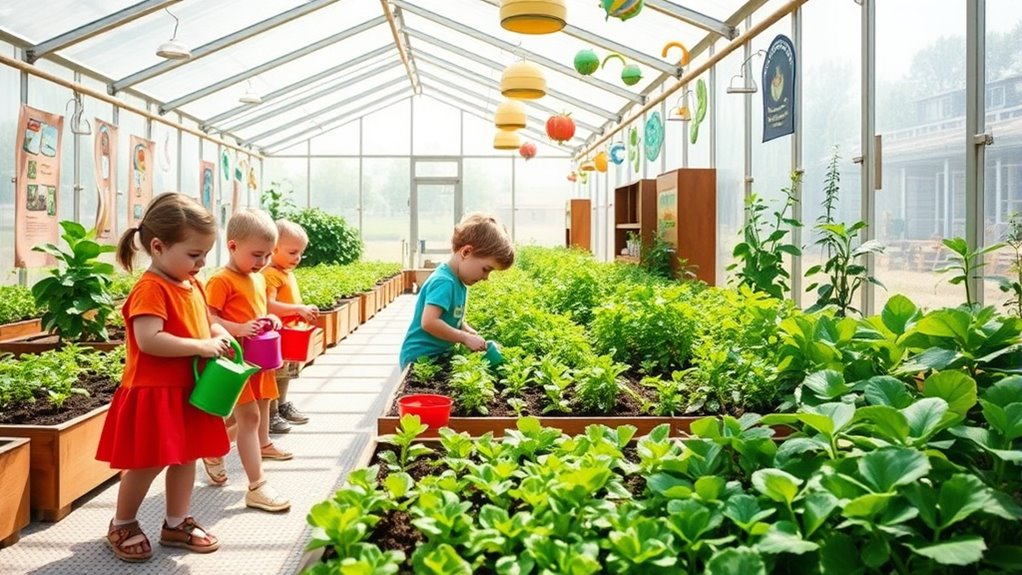
How can you create a greenhouse environment that’s safe and engaging for children? Start by prioritizing children’s greenhouse safety, ensuring sturdy structures, non-toxic materials, and secure pathways. Use rounded edges and low shelves to minimize accidents. Incorporating educational signage about sustainable practices can enhance learning and environmental awareness. Designing interactive greenhouse spaces encourages exploration and learning; incorporate hands-on activities like planting stations, sensory zones, and easy-to-reach tools. Bright colors and clear signage help children navigate the space confidently. Provide shaded areas for rest and ensure good ventilation for comfort. Including essential oils for safety awareness can also help teach children about natural products and their proper use, fostering responsible habits. Teaching children about self watering plant pots can introduce them to innovative gardening methods and the importance of water conservation. Involving kids in the design process fosters ownership and curiosity. Implementing juice cleanse and detox principles can teach children about healthy habits and natural nutrition, making the learning experience more comprehensive. Additionally, understanding WWE Raw’s financial impact demonstrates how entertainment can influence perceptions of value and sustainability in society. By combining safety measures with engaging, interactive features, you create an environment where children feel secure and excited to learn about sustainability through active participation.
Incorporating Sustainability Concepts Into Greenhouse Activities
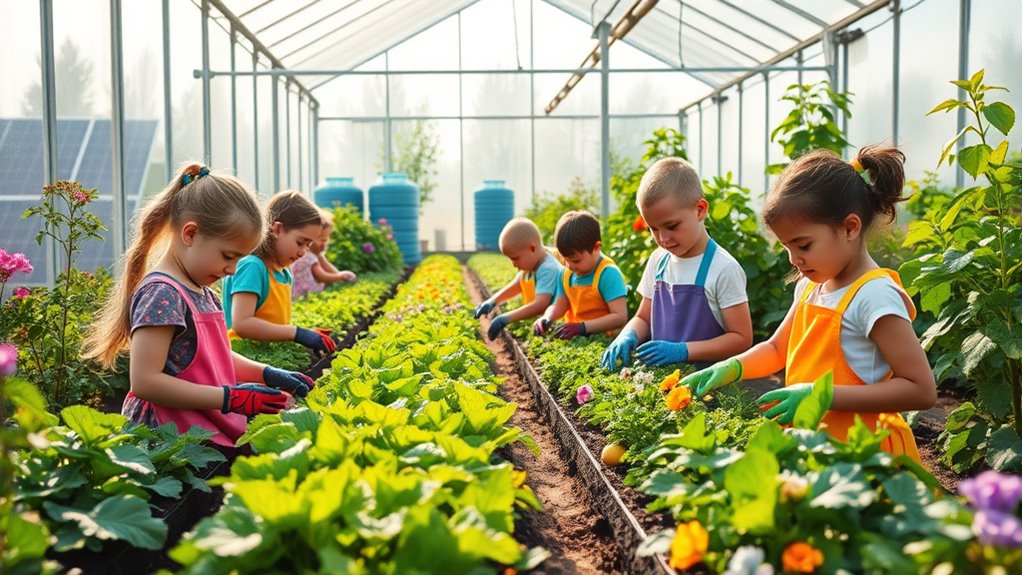
Integrating sustainability concepts into greenhouse activities offers children hands-on opportunities to understand environmental responsibility. You can teach them about solar energy by installing small solar panels to power greenhouse fans or lights, showing how renewable energy works. Incorporating eco-friendly materials in gardening tools and supplies can further reinforce the importance of sustainable choices. Encourage composting techniques by setting up a compost bin where kids can recycle plant waste, learning about soil enrichment and waste reduction. Other ideas include collecting rainwater for watering plants, discussing water conservation, and using organic fertilizers to promote eco-friendly gardening. You can also involve children in monitoring energy use and composting progress, fostering awareness of eco-friendly practices. Additionally, incorporating relationship-building exercises into group projects can enhance teamwork and communication skills among young learners, making sustainability education more effective and engaging. Understanding sustainable practices can inspire children to adopt eco-conscious habits both in the garden and beyond. Furthermore, introducing them to concepts of climate change impact can deepen their understanding of how human actions influence the environment and the importance of sustainable living.
Hands-On Learning: Planting and Caring for Greenhouse Crops
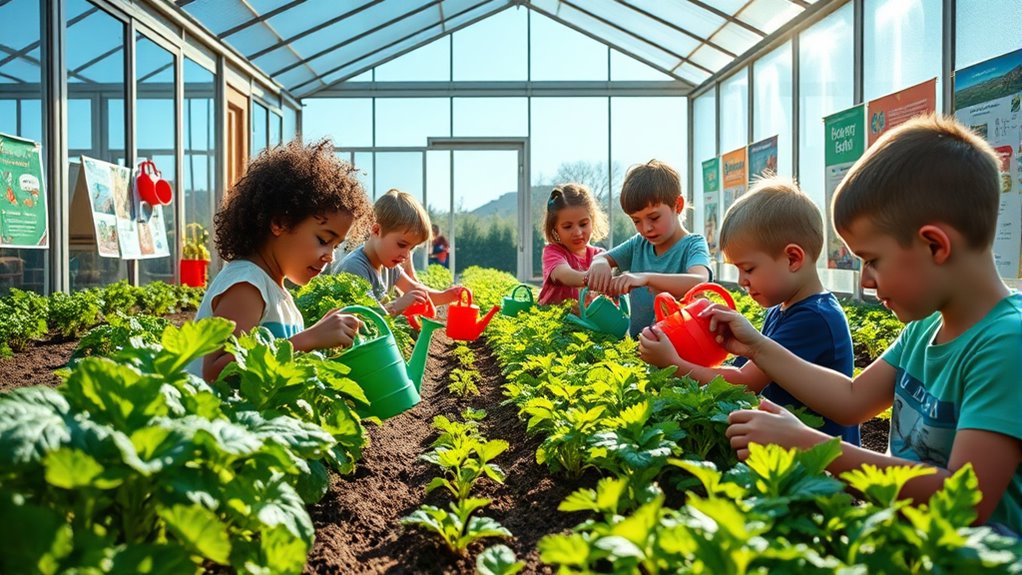
When you start planting greenhouse crops, choosing the right plants is key to success. You’ll learn proper planting techniques to give your crops the best start. Additionally, understanding the importance of climate control helps create an optimal environment for your plants to thrive. Proper soil preparation can also significantly impact plant health and yield. Then see how caring for them helps them thrive. This hands-on approach teaches valuable lessons about sustainability and responsibility.
Selecting Suitable Crops
Choosing the right crops is essential for a successful greenhouse project, especially when teaching children about sustainability. Your crop selection should consider growing considerations like climate, space, and maintenance needs. Selecting crops that are adaptable to various conditions ensures a more reliable harvest and learning experience. Picking easy-to-grow plants helps kids stay engaged and learn quickly. Think about crops that thrive in a greenhouse environment, such as:
- Leafy greens like lettuce and spinach
- Herbs like basil and cilantro
- Cherry tomatoes
- Radishes
- Strawberries
These options are fast-growing, resilient, and require minimal resources. Additionally, understanding financial management principles can teach children the importance of budgeting and resource allocation in sustainable farming. Incorporating crop rotation techniques can also help maintain soil health and prevent pests naturally. Employing proper watering techniques ensures plants receive adequate hydration without waste, reinforcing conservation principles. Promoting biodiversity within the greenhouse can further support pest control and ecosystem balance. Integrating organic seed cultivation practices ensures healthier plants and promotes ecological sustainability.
Proper Planting Techniques
To guarantee your crops grow healthy and strong, mastering proper planting techniques is essential. Start with soil preparation by ensuring the soil is loose, well-draining, and rich in nutrients. This creates an ideal environment for seed growth. Proper soil preparation is crucial for setting a solid foundation for your plants’ development. Additionally, understanding the fundamentals of SQA can help you implement best practices for maintaining soil health and monitoring crop progress effectively.
When selecting seeds, choose high-quality, disease-resistant varieties suited for your climate and season. Follow the seed packet instructions for planting depth and spacing to promote healthy roots and prevent overcrowding.
Gently press the seeds into the soil without compressing it too hard, allowing for proper water absorption. Water the planted seeds carefully to keep the soil moist but not waterlogged.
Proper soil preparation and seed selection lay the foundation for a successful greenhouse crop, giving your young plants the best start possible.
Caring for Greenhouse Plants
Taking hands-on care of your greenhouse plants is essential for ensuring they thrive throughout their growth. Regularly monitor your crops for signs of pests or disease and act quickly to manage pest issues through integrated pest management techniques.
Proper greenhouse maintenance, like cleaning surfaces and ensuring good airflow, helps prevent problems and keeps plants healthy. You should also:
- Water plants consistently, avoiding over- or underwatering
- Prune and thin plants to promote airflow and growth
- Remove dead or diseased leaves promptly
- Check for pests daily and use natural control methods when needed
- Maintain proper humidity and temperature levels
Teaching About Water Conservation and Waste Reduction
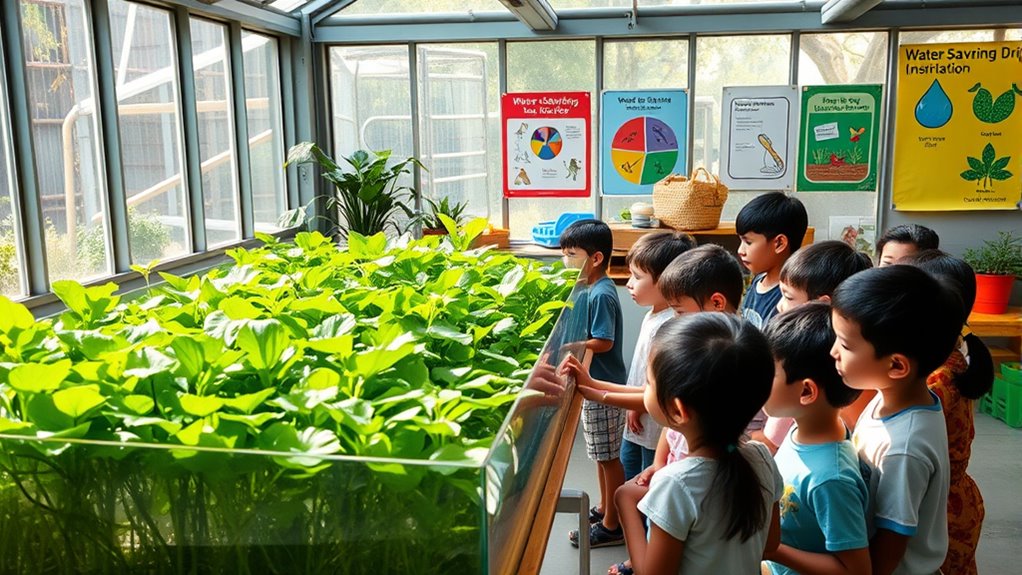
Teaching children about water conservation and waste reduction is essential for nurturing environmentally responsible habits early on. You can introduce concepts like rainwater harvesting, showing how collecting rainwater reduces reliance on tap water and conserves resources.
Explain how water-efficient irrigation methods, such as drip systems, target water directly to plants, minimizing waste. Encourage kids to think about reducing waste through recycling and composting, emphasizing the importance of reusing materials and reducing landfill contributions.
Exploring Biodiversity and Ecosystem Interactions

Understanding how different plants, animals, and insects interact within an ecosystem helps us see how nature stays balanced. These interactions keep ecosystems healthy and productive.
For example, pollinator diversity ensures plants reproduce, supporting food chains. Soil interactions help plants absorb nutrients, which in turn feeds animals and insects.
You can observe:
- Bees and butterflies pollinating flowers
- Soil microbes breaking down organic matter
- Predators controlling pest populations
- Plants providing shelter for insects
- Animals dispersing seeds
Promoting Recycling and Reuse Through Greenhouse Projects
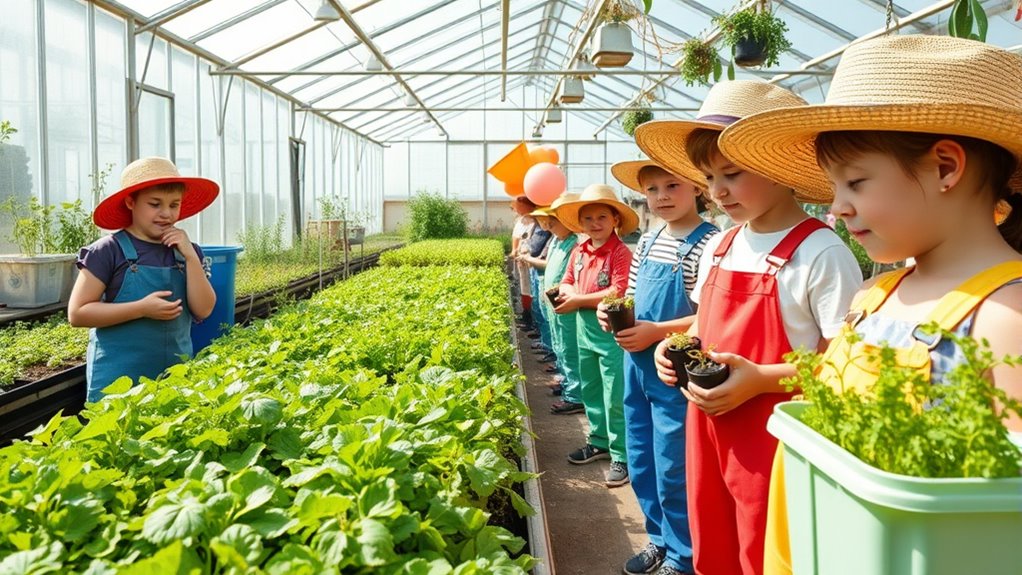
Building on the importance of ecosystem interactions, involving children in greenhouse projects offers a hands-on way to promote recycling and reuse. You can encourage kids to create recycling art from recyclable materials or design reusable container projects for planting. This approach teaches them the value of reducing waste while fostering creativity. By repurposing items, children see firsthand how reuse benefits the environment. Use this table to generate ideas:
| Recycling Art Ideas | Reusable Container Projects |
|---|---|
| Collage from bottle caps | Plant herbs in old jars |
| Sculpture from cardboard | Use plastic bottles as planters |
| Mosaic from broken dishes | Create seedling trays |
| Art from scrap paper | Make watering cans from cans |
Integrating Technology and Data Collection in Greenhouse Lessons
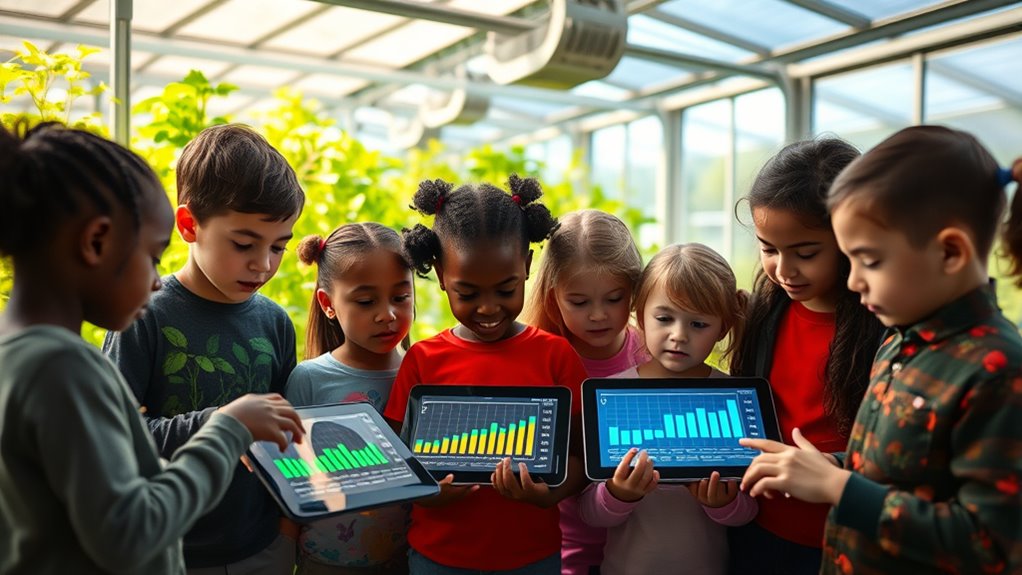
By integrating technology into greenhouse lessons, you can easily monitor environmental conditions like temperature and humidity.
Using digital tools, you can collect and analyze plant growth data to track progress and identify patterns.
This approach helps students engage actively with real-time information and develop essential data skills.
Monitoring Environmental Conditions
Integrating technology into greenhouse lessons allows students to monitor environmental conditions more accurately and interactively. You can use sensors and data loggers to track temperature, humidity, soil moisture, and light levels in real-time. This helps students understand how these factors influence soil health and pest management.
Imagine students checking digital dashboards, analyzing graphs, and adjusting conditions to optimize plant growth. This hands-on approach enhances their understanding of sustainability. You might include tools like soil pH testers or pest traps connected to monitoring systems.
The technology encourages curiosity and problem-solving, making environmental data tangible. Students learn to interpret data critically, fostering a deeper awareness of how environmental conditions impact greenhouse ecosystems and sustainability efforts.
Analyzing Plant Growth Data
Analyzing plant growth data using technology transforms greenhouse lessons into engaging, hands-on learning experiences. You can conduct photosynthesis experiments by measuring oxygen output or chlorophyll levels, helping children understand how light and CO₂ influence growth.
Additionally, soil composition analysis with digital tools allows students to examine nutrient levels, pH, and moisture content, revealing how soil health impacts plant development. Collecting and analyzing this data encourages critical thinking and scientific inquiry.
Using sensors and digital recording devices makes data collection more accurate and efficient, enabling students to identify patterns and draw meaningful conclusions. This approach not only deepens their understanding of plant biology but also highlights the importance of sustainability practices in agriculture.
Ultimately, data-driven lessons make complex concepts accessible and exciting.
Utilizing Digital Learning Tools
Utilizing digital learning tools in greenhouse lessons transforms traditional experiments into interactive, engaging experiences. You can take students on virtual tours of sustainable farms or greenhouses worldwide, broadening their understanding of eco-friendly practices.
Digital storytelling allows children to create narratives around plant growth, climate impact, and conservation efforts, making lessons more meaningful. Incorporate tools like interactive apps, online data collection platforms, and multimedia presentations to enhance learning.
These technologies foster curiosity and deepen understanding of sustainability concepts. By blending real-world data with digital visuals, students develop critical thinking and problem-solving skills.
With virtual tours and storytelling, your lessons become immersive, inspiring future stewards of the environment. This approach makes learning about greenhouses dynamic, relevant, and fun.
Encouraging Critical Thinking and Problem-Solving Skills

To effectively teach children about sustainability, you need to foster their critical thinking and problem-solving skills from an early age. Greenhouses provide an ideal setting for this, as they encourage kids to analyze real-world challenges and develop solutions.
You can introduce activities that ask children to identify issues like water waste or energy use, then brainstorm ways to improve efficiency. By engaging in hands-on tasks, children learn to evaluate options, weigh consequences, and make informed decisions.
This process sharpens their critical thinking and builds resilience in problem-solving. Encouraging questions and discussions further deepens understanding, empowering children to approach sustainability with curiosity and confidence.
These skills are essential for nurturing environmentally responsible adults.
Fostering a Sense of Environmental Responsibility Through Greenhouse Stewardship
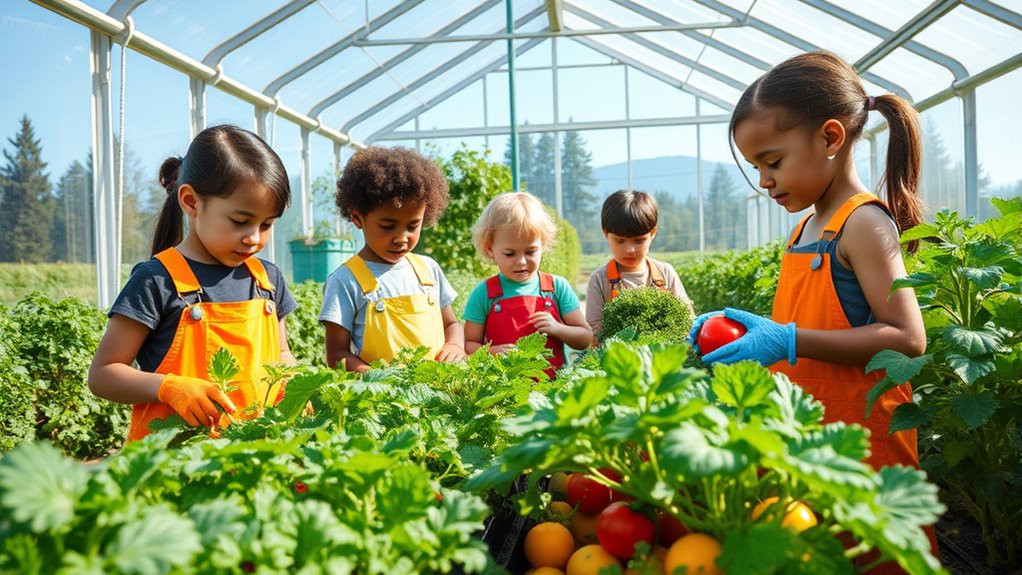
Getting children involved in hands-on greenhouse activities helps them understand the importance of conservation principles firsthand.
As they learn to care for plants and resources, they naturally develop eco-friendly habits.
This active participation fosters a sense of environmental responsibility that can last a lifetime.
Hands-on Greenhouse Activities
Engaging children in hands-on greenhouse activities offers a powerful way to cultivate their environmental responsibility. Through activities like seasonal planting, they learn about the importance of local food systems and plant growth cycles.
Involving kids in adjusting greenhouse ventilation teaches them how to control temperature and humidity, fostering an understanding of sustainable climate management. You can also encourage them to:
- Plant seedlings and observe growth stages
- Monitor and record temperature and humidity levels
- Adjust vents to optimize airflow
- Compost organic waste for soil health
- Water plants with care and precision
These activities give children direct experience in maintaining a healthy greenhouse environment. They develop a sense of stewardship, understanding that their actions impact sustainability and the health of our planet.
Learning Conservation Principles
Building on hands-on greenhouse activities, fostering a sense of environmental responsibility involves teaching children conservation principles that guide their actions beyond the greenhouse. You can help them understand how water cycles sustain plant life and why conserving water is essential. Explain how reducing water waste supports these natural processes and benefits the environment.
Additionally, emphasize soil preservation, showing how healthy soil maintains plant growth and prevents erosion. Encourage children to practice composting and avoid harmful chemicals to protect soil quality.
Promoting Eco-Friendly Habits
Have you ever thought about how small daily actions can make a big difference for the environment? By promoting eco-friendly habits, you help children develop a sense of environmental responsibility through greenhouse stewardship.
Encourage them to participate in recycling initiatives, sorting waste properly, and understanding its impact. Introduce composting practices to teach about waste reduction and natural soil enrichment.
Imagine children:
- Recycling plastic bottles and paper
- Composting food scraps and yard waste
- Turning off unused lights and appliances
- Using reusable bags and containers
- Saving water during daily activities
These habits foster a mindset of sustainability. When kids see their efforts make a difference, they’re more likely to continue eco-friendly behaviors, becoming responsible stewards of the environment now and in the future.
Frequently Asked Questions
How Can Greenhouses Help Children Understand Climate Change Impacts?
You can use greenhouses to teach kids about climate change impacts by showing how controlled environments respond to external weather conditions. This hands-on approach boosts climate education and eco literacy, making complex concepts tangible.
Children observe how temperature, humidity, and plant growth change with climate shifts. Greenhouses serve as practical tools, helping them understand the importance of sustainable practices and fostering awareness of environmental challenges firsthand.
What Are Effective Methods to Involve Students in Greenhouse Maintenance?
Ever wondered how you can truly engage students in greenhouse care? You can involve them through student-led projects and hands-on activities, empowering their sense of responsibility. Assign roles like watering, planting, and monitoring growth, encouraging teamwork and ownership.
Do they feel motivated when they see their efforts directly impact the greenhouse’s success? Facilitating such active participation makes learning about sustainability meaningful and memorable, fostering future environmental stewards.
How Does Greenhouse Education Influence Students’ Long-Term Environmental Behaviors?
Greenhouse education encourages behavioral change and boosts environmental awareness by engaging you in hands-on learning. As you care for plants and learn about ecosystems, you develop a deeper understanding of sustainability.
This active participation makes you more likely to adopt eco-friendly habits long-term. By experiencing the tangible impact of your actions, you become more committed to protecting the environment, leading to lasting positive behavioral changes.
What Challenges Exist in Implementing Greenhouses in Under-Resourced Schools?
Did you know that over 60% of under-resourced schools face funding barriers?
You’ll find that implementing greenhouses is tough because of limited financial support and inadequate technical training. These barriers make it hard to establish and maintain greenhouses, limiting hands-on sustainability education.
Overcoming these issues requires targeted funding and specialized training programs, so students can benefit from experiential learning and develop lasting environmental awareness.
How Can Greenhouses Be Adapted for Different Age Groups and Learning Levels?
You can adapt greenhouses for different age groups by designing age-appropriate activities that match their developmental levels. For younger children, focus on interactive learning with simple planting tasks and sensory exploration.
Older students can engage in more complex projects like monitoring plant growth and sustainability practices. Incorporate hands-on experiments and collaborative tasks to keep learning engaging.
This approach guarantees each age group benefits from meaningful, tailored greenhouse experiences that foster sustainability awareness.
Conclusion
By engaging children with greenhouses, you open their eyes to sustainability and nurturing the planet. As they plant, care for, and learn about conservation, you help them see a greener future—one they can shape. Imagine a world where every child understands the importance of protecting our environment. Isn’t it time you encouraged their curiosity and responsibility through greenhouse education, planting seeds today for a sustainable tomorrow?
